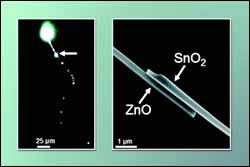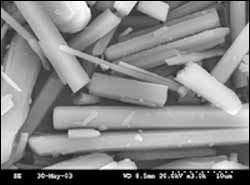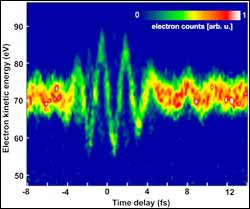Power and Electrical Engineering
This topic covers issues related to energy generation, conversion, transportation and consumption and how the industry is addressing the challenge of energy efficiency in general.
innovations-report provides in-depth and informative reports and articles on subjects ranging from wind energy, fuel cell technology, solar energy, geothermal energy, petroleum, gas, nuclear engineering, alternative energy and energy efficiency to fusion, hydrogen and superconductor technologies.

A Guiding Light on the Nanoscale
Another important step towards realizing the promise of lightning fast photonic technology has been taken by scientists with the U.S. Department of Energy’s Lawrence Berkeley National Laboratory (Berkeley Lab) and the University of California at Berkeley. Researchers have demonstrated that semiconductor nanoribbons, single crystals measuring tens of hundreds of microns in length, but only a few hundred or less nanometers in width and thickness (about one ten-millionth of an inch), can serve as “wa

Natural mineral locks up carbon dioxide
A common mineral can remove carbon dioxide from combustion gases, but in its natural state, it is glacially slow. Now, a team of Penn State researchers is changing serpentine so that it sequesters the carbon dioxide from fossil fuel burning in hours, not eons.
“Serpentine naturally sequesters carbon dioxide over geologic time, but it is too slow to help us,” says Dr. M. Mercedes Maroto-Valer, assistant professor of energy and geo-environmental engineering and program coordinator fo

Vulnerability of US power grid identified
Vulnerabilities inadvertently built into the U.S. power grid, which is one of the most complex systems ever constructed, have been identified by a research team lead by Reka Albert, assistant professor of physics at Penn State. The team’s topological analysis of the grid structure reveals that, although the system has been designed to withstand the random loss of generators or substations, its integrity may depend on protecting a few key elements.
“Our analysis indicates that

Light oscillations become visible
Austrian-German research team demonstrates for the first time an attosecond “oscilloscope” rendering the hyper-fast field oscillations of visible light
The human eye can detect changes in the intensity of light, not however the wavelength because light oscillates too fast (approximately 1000 trillion times per second). An international collaboration led by Ferenc Krausz and made up of researchers from the Vienna University of Technology, the Max-Planck-Institute for Quantum Opt

Environmental costs of home construction lower with wise choice, reuse of building materials
Most of the energy that goes into building U.S. homes is consumed – not by the power tools, welding and trucking during construction – but during the manufacture of the building materials, according to a comprehensive life-cycle assessment comparing typical wood-, steel- and concrete-frame homes.
Using the least energy-intensive building materials – and taking steps toward such things as recycling and reusing more building materials – makes sense considering the nation’s energy conc

Molecular assemblies created to convert water to hydrogen gas
Wonder where the fuel will come from for tomorrow’s hydrogen-powered vehicles? Virginia Tech researchers are developing catalysts that will convert water to hydrogen gas. The research will be presented at the 228th American Chemical Society National Meeting in Philadelphia August 22-26, 2004
Supramolecular complexes created by Karen Brewer’s group at Virginia Tech convert light energy (solar energy) into a fuel that can be transported, stored, and dispensed, such as hydro